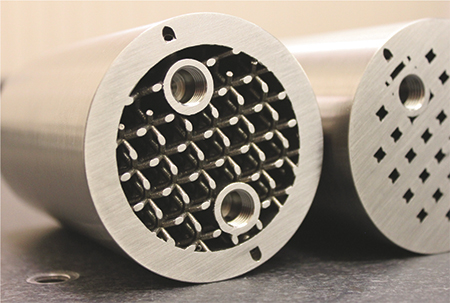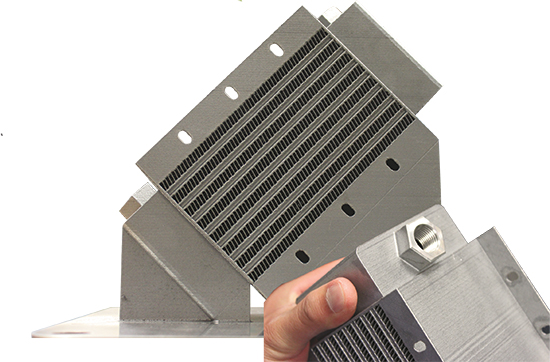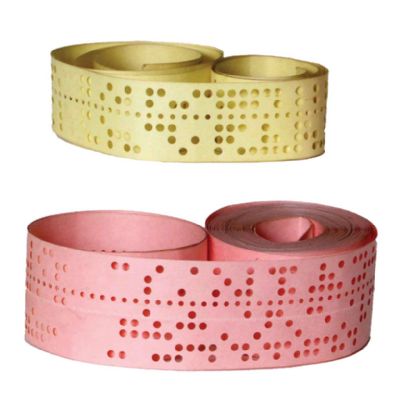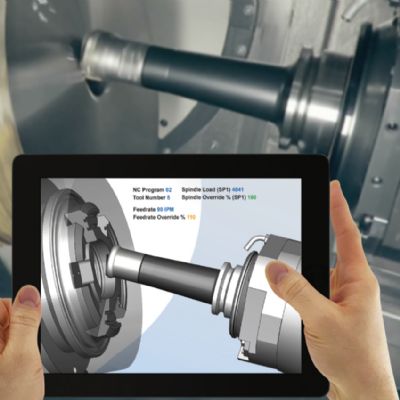“Semiconductor-industry work is where we first started dealing with heat issues—high-heat thermal processing and materials that are particularly suited for that environment,” says Joest. “Add to that the insight we gained into the world of titanium and how to make structures lighter, and that prepared us for additive manufacturing.”
Recognized AM as a Perfect Fit
It was the following generation, namely Joest’s son Christian, that helped lead Imperial through its next stage of evolution.
In 2012, Joest was on the lookout for a new opportunity for Imperial to exploit and was researching five-axis machining centers. But a news story on an AM-related business acquisition provided the pivot point.
 |
| This cylindrical component, made from Inconel, features a printed lattice structure and precision-machined surfaces. |
“Almost immediately I identified that, given the industries that we are in—the heavy end of the innovation industries for tech, and the lightweight industries and innovation side of the military—additive, particularly metal-additive, would be something very interesting to our customers,” he says. “So we jumped in and in 2013 bought our first additive machine, an SLM 280 machine from SLM Solutions.”
With that selective-laser-melting system inhouse, “Christian and a couple of other employees grabbed the technology and wrestled it to the ground for the first couple of years,” says Joest, revealing that learning AM capabilities and applications took some time. But 5 years later, with another SLM 280 onboard, this one a twin-laser model, along with supporting polymer-printing machines, Imperial is full bore into leveraging its precision-machining/AM capabilities.
“The combination of our extensive multiaxis-machining and welding and complex-assembly capabilities, along with customers that include the U.S. government and the biggest tech ventures in the world, gives us an automatic entry into an environment where every 3D structure that we manufacture must be machined,” Joest says.
Trial-and-Error Success
By Joest’s own admission, Imperial stumbled out of the gate with AM technology, but recognized it as the only way to proceed. Remember, in 2013 not nearly as much AM data were available.
“We knew that the new AM machine could do powerful things, but we didn’t know the quirks of the technology and the AM industry,” explains Christian. “So my dad set me and someone else here on it to grab the bull by the horns. We learned the programming side of it and learned how to perform powder changes. Dad said, ‘Look guys, print whatever you want but we have to figure out how to make functional pieces that work in an environment that we are comfortable selling into.’”
For nearly a year, Christian and his team printed random parts and tested out surface finishes to get a handle on geometry and tolerance capabilities of the process.
“The idea was, just print this structure and see if it works, and if it doesn’t we know that this certain overhang can’t be printed or this certain geometry seems funky,” Christian says. “It took about 2 years until we really felt comfortable with what we were producing. Even today, we may have part designs where we don’t know how they’ll warp or what type of tolerances can be delivered. But in the last 3 years we have gotten comfortable selling into the markets that we were used to, producing high-end components for a variety of industries.”
Imperial prints most frequently in titanium, but also prints stainless steel, aluminum and Inconel, with cobalt-chromium and maraging steel finding use in some applications, according to Joest. He notes that it even prints type-4340 steel using parameters developed in conjunction with the U.S. Army.
Training for AM Work
 |
Material is cleaned off of build plate as part of Imperial Machine & Tool’s extensive metal 3D-printing operations.
|
Besides offering a robust apprenticeship and training program for the new hires among its 40 employees, Imperial conducts ongoing training and cross-training to ensure that all employees have a comfort level with AM, and then promotes from within.
“When we folded additive into our operations, it became just another workcenter for us,” says Joest. “We staff that workcenter with talented people, typically off of our shop floor. For example, right now we are running our lead welder and another shop-floor employee through our additive training program so that they can prepare and load AM tools, and build parts.
“It is all part of our efforts to offer people lifetime employment,” he continues. “I would like our employees to retire from this company someday. In between, I try to challenge them professionally as an advanced-employment opportunity. This is an environment where people are excited by what we are doing, and all of us embrace challenges.”
Products Prove Out Manufacturing
Due to classified work with military clients and secretive projects with others, Joest is not at liberty to discuss some of Imperial’s most earth-shattering AM successes, but hints of the company’s prowess are out there. For example, Imperial works with the Center for Innovative Materials Processing through Direct Digital Deposition (CIMP-3D), operated by Penn State University and its partners, Battelle Memorial Institute and 3D Systems. CIMP-3D’s mission is to advance and deploy AM technology of metallic and advanced material systems to industry.
Bringing Customers Onboard with AM As much as additive manufacturing (AM) requires a learning curve for the manufacturer, its customers, ranging from those with little knowledge of the process to those with a keen understanding, must also be brought up to speed. Imperial Machine & Tool, Inc., is no exception. “Our customers are willing to embrace certain things, and we lead the charge when guiding them through technological advancements,” explains Chris Joest, president. “We rarely run across customers that are as well-versed in AM as we are. In the past, it was a clear relationship between Imperial and our customers. They develop a technical data package, we quote a price, we build it, and then go back to that data package and review what we’ve done. Customers undergo this same process with three or four other shops, and they can easily figure out an appropriate way forward. That is not the case with additive. We have engagement much earlier than that. “But we deal with customers that are leading innovators, which helps a lot,” Joest continues. “Many of our customers will say, ‘Let’s try this.’” Many times, Imperial and its customers have learned about AM and hybrid capabilities together. “For example, Imperial and the U.S. government have insight into what will happen, but we both stand around the tool and say, ‘Let’s see what happens.’ Most of our customers are willing to try a new methodology.” What advice does Joest offer customers regarding the marriage of AM and precision machining? “If it can be built subtractively, and it has been designed subtractively, that is the best way forward,” he says. “But if there are features in a product that cannot be achieved effectively through conventional subtractive technology, then we discuss with a customer in detail why additive should be considered. These cases almost always involve a certain portion of a structure that cannot be readily built in the conventional environment–often a weldment or internal passage. “Our focus is developing products that cannot be made another way,” Joest continues. “We have to get that across to our customers, and when they understand that, ideas blossom and we help them through design and manufacturability issues. It is a very collaborative process.” |
Two projects with CIMP-3D highlight Imperial’s additive/subtractive capabilities, as explained by Wes Hart, the company’s marketing director. One is a cylindrical component printed from Inconel and featuring a lattice structure and precision-machined surfaces. This component can only be produced by manufacturers using a combination 3D-printing/precision-machining process.
More recently, according to Hart, Imperial collaborated with CIMP-3D on an AM heat exchanger.
“Compared to the traditionally manufactured counterpart, the printed heat exchanger yielded a significant improvement in cooling capability,” he says. “The laser-powder-bed-fusion process leaves a surface finish that’s rougher than a machined component, resulting in increased surface area and better heat transfer. The next generation of AM heat exchangers will build off the things we learned, and incorporate complex internal geometries that can be achieved only through additive manufacturing.”
Joest offered this during a presentation at the RAPID event this past May in Pittsburgh: “We’ve been successful making extremely lightweight manifolds by employing the hybrid-manufacturing approach. We rely on our SLM machines to produce intricate geometries and perform five-axis precision machining to achieve critical mating surfaces and complex features. The result is a high-performance manifold that cannot be produced any other way.
“It takes an experienced metal-additive department,” he continues, “but more importantly, an experienced team of machinists, welders and engineers to finish things properly.”
Imperial also employs nonmetal 3D printing in a supporting role for machining operations, namely custom fixturing, but not as a service for others.
“Picture a crazy little weldment with odd angles that requires precision features,” explains Joest. “If we can print the negative of that and hold the part, that is a great application for us and it has worked out well. Any business that uses jigs and workholding fixtures can do this very easily, and it will quickly make a difference on the shop floor.”
The evolution of AM at Imperial has delivered spin-off businesses, including a 3D-printing house, Imperial 3D Solutions, and a software company, Solid Innovations, which successfully developed in situ monitoring products that help control the build process, measure tolerances and verify quality.
That Rising Tide
Joest certainly sees AM and precision machining as complementary processes and a successful way forward for machining businesses. But absolutely the wrong approach is to duck your head in the sand about AM.
“I was talking to someone at RAPID who makes fasteners for airplane skins,” Joest recalls. “He said that AM is nothing he has to worry about because this process doesn’t make fasteners. I asked him, ‘What if companies develop airplane skins with fasteners 3D-printed into them, or AM enables a skin that doesn’t require fasteners at all?’ The idea that ‘this will never impact my business’ needs to be reassessed.”
In the meantime, Joest wants to get the word out on AM to his machine-shop brethren:
“Join the party!” 3DMP
Industry-Related Terms: Case,
Center,
CNC,
Manufacturability,
Model,
Plate,
Run,
Stainless Steel,
Surface,
Tolerance,
TransferView Glossary of Metalforming Terms
See also: SLM Solutions NA, Inc., Imperial Machine & Tool Co.
Technologies:
 Lou Kren
Lou Kren











